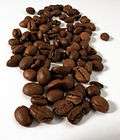Coffee substitute

Coffee substitutes are non-coffee products, usually without caffeine, that are used to imitate coffee. Coffee substitutes can be used for medical, economic and religious reasons, or simply because coffee is not readily available. Roasted grain beverages are common substitutes for coffee.
In World War II, acorns were used to make coffee, as were roasted chicory and grain. During the American Civil War coffee was also scarce in the South:[1]
For the stimulating property to which both tea and coffee owe their chief value, there is unfortunately no substitute; the best we can do is to dilute the little stocks which still remain, and cheat the palate, if we cannot deceive the nerves.— "Substitutes for Coffee", The Southern Banner, 1865
Coffee substitutes are sometimes used in preparing foods served to children or to people who avoid caffeine, or in the belief that they are healthier than coffee. For religious reasons, members of the Church of Jesus Christ of Latter-day Saints, also known as Mormons, refrain from drinking coffee,[2] but not all hot drinks;[3] some may drink a substitute.[4]
Some culinary traditions, like that of Korea, include beverages made from roasted grain instead of coffee or tea (including boricha, oksusu cha, and hyeonmi cha). These do not substitute for coffee but fill its niche as a hot drink (optionally sweetened).
Ingredients
Grain coffee and other substitutes can be made by roasting or decocting various organic substances.
Some ingredients used include almond, acorn, asparagus, malted barley, beechnut, beetroot, carrot, chicory root, corn, soybeans, cottonseed, dandelion root (see dandelion coffee), fig, roasted garbanzo beans, boiled-down molasses, okra seed, pea, persimmon seed, potato peel,[5] rye, sassafras pits, sweet potato, wheat bran.
The Native American tribes of what is now the Southeastern United States brewed a ceremonial drink containing caffeine, "asi", or the "black drink", from the roasted leaves and stems of Ilex vomitoria (Yaupon holly). European colonists adopted this beverage as a coffee-substitute, which they called "cassina".[6]
Ground roasted chicory root has been sold commercially on a large scale since around 1970, and it has become a mainstream product, both alone and mixed with real coffee. It was widely used during the American Civil War on both sides, and has long enjoyed popularity especially in New Orleans, where Luzianne has long been a popular brand in this respect. Chicory mixed with coffee is also popular in South India, and is known as Indian filter coffee.
Postum is an instant type of coffee substitute made from roasted wheat bran, wheat and molasses. It reached its height of popularity in the United States during World War II when coffee was sharply rationed.
Examples
- Barleycup is a similar product sold in the UK.
- Camp Coffee is a mix of chicory and coffee from the UK, sold since 1876.
- Nestlé Caro is made of roasted barley, malted barley, chicory, and rye and is used as a coffee substitute.[7]
- There are many dandelion (or chicory) based powdered coffee substitutes known as dandelion coffee.
- Inka is a Polish drink made of rye, barley, chicory, and sugar beet, produced since 1971.
- Ayurvedic Roast is a coffee substitute which borrows from both the American tradition of using roasted barley, rye, and chicory, and the Indian Ayurvedic system of health by adding the traditional herbs of ashwagandha, shatavari, and brahmi.[8]
- Ersatz is made of roasted rice, roasted peas, and roasted chicory.
- Muckefuck, a generic term in Germany for coffee substitutes, possibly from the French "mocca faux".[9]
- New Life Coffee produces a caffeine-free coffee substitute from roasted soybeans.[10]
- Ricoré is a mix of chicory and coffee from France created in 1953, now produced by Nestlé.
- Teeccino Caffé produces blends of coffee substitute from a variety of ingredients such as carob, chicory, and dandelion roots.[11]
- Postum, once popular among Mormons, is made from roasted wheat bran, wheat and molasses.
- Choffy is a recent substitute made from cacao and brewed like coffee.
- Roasted chickpeas were noted as a coffee substitute as early as the 18th century.[12] Modern brands include Bueno Coffee Substitute in the continental United States and Machotes in Puerto Rico.
Preparation
- Some commercially available preparations are finely powdered and dissolve instantly in hot water
- Some coffee substitutes, like chicory, are ground and brewed like coffee
- Some coffee substitutes, like roasted barley grains, are left whole and boiled and steeped like tea
See also
References
- ↑ "Substitutes for Coffee". The Southern Banner. Athens, Georgia. March 15, 1865. p. 1 col. 4 – via Confederate Coffee Substitutes: Articles from Civil War Newspapers.
- ↑ Mormon scripture: Doctrine and Covenants section 89, 1-9; written in 1833
- ↑ The LDS Church interprets "hot drinks" to mean coffee and tea.
- ↑ In the same section of scripture, an alternative for coffee is offered
- ↑ Potato Coffee
- ↑ http://www.econbot.org/_about_/06_awards/awards_morton/pdfs/a_edwards.pdf Edwards, Adam. (2002) "Variation of caffeine and related alkaloids in Ilex vomitoria Ait. (Yaupon holly): A model of intraspecific alkaloid variation". Society for Economic Botany Julia F. Morton Award.
- ↑ Caro Malzkaffee
- ↑ Ayurvedic Roast Coffee Substitute
- ↑ http://www.dw.de/muckefuck/a-6615948
- ↑ "New Life Coffee Coffee Substitute".
- ↑ Teeccino's Ingredients | Teeccino Herbal Coffee / Coffee Alternative
- ↑ "Introduction: Chickpeas". International Center for Agricultural Research in the Dry Areas. Archived from the original on 18 July 2012. Retrieved 28 August 2008.
